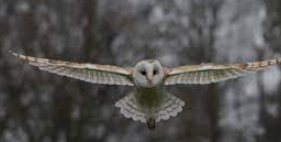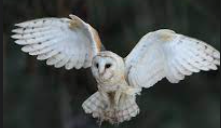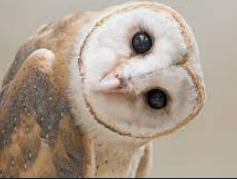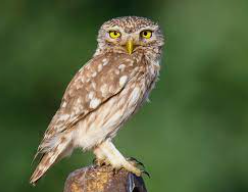Owls: Whoose Hoo?

Placed in pop culture as the wise sage and ominous symbol, the owl is actually an interesting animal that comes in many forms. There are over 155 species of owl that are known to live in nearly any climate. However, they wouldn’t be classified within the same species if they did not share several important traits. These traits are what make owls one of the strongest predators in the world and one of the longest surviving species.
Physiology
 Owl bodies are made of the same basic parts as most animals, but have strong adaptations that set them apart from the rest of the animal kingdom. An owl’s face can be large or small in either a round or heart shape. The shape of an owl’s face depends on the type of prey it hunts; the eyes are arranged to best see prey and the beak to best consume each specific type of prey. Owl feathers display colors and patterns that help them camouflage with their surroundings, so they can both hide from predators and stalk prey. For example, the African Scops Owl blends in with native trees, the Little Owl with moss and rocks, and the Snowy Owl with ice and snow. An owl’s wings are significantly stronger than the average bird, moving very quickly and quietly for such a large bird. In fact, owls have unique feathers with extra soft edges that make them nearly entirely silent so that prey cannot hear them approaching.
Owl bodies are made of the same basic parts as most animals, but have strong adaptations that set them apart from the rest of the animal kingdom. An owl’s face can be large or small in either a round or heart shape. The shape of an owl’s face depends on the type of prey it hunts; the eyes are arranged to best see prey and the beak to best consume each specific type of prey. Owl feathers display colors and patterns that help them camouflage with their surroundings, so they can both hide from predators and stalk prey. For example, the African Scops Owl blends in with native trees, the Little Owl with moss and rocks, and the Snowy Owl with ice and snow. An owl’s wings are significantly stronger than the average bird, moving very quickly and quietly for such a large bird. In fact, owls have unique feathers with extra soft edges that make them nearly entirely silent so that prey cannot hear them approaching.

 Despite being famous for their keen sight, owls cannot move their eyes. Instead, they can turn their head 180 degrees and twist it upside down to get the best view of their surroundings. Owls can see in the dark and hunt mostly at night. But vision is not their only sensory advantage, owls can hear a mouse moving from over 75 feet away.
Despite being famous for their keen sight, owls cannot move their eyes. Instead, they can turn their head 180 degrees and twist it upside down to get the best view of their surroundings. Owls can see in the dark and hunt mostly at night. But vision is not their only sensory advantage, owls can hear a mouse moving from over 75 feet away.
When hunting, owls use their strong feet to pounce prey. From there, they carry the food with their sharp talons, and tear it apart with their sharp beak. Owls do not have teeth, and therefore do not chew their food. They either tear it into extremely small pieces with their curved beaks, or they swallow their food whole. They later regurgitate the inedible parts of food in small pellets.
Diet
Owls, like most predatory birds, eat mostly mice or other rodents native to their area. They also eat snakes, insects, and fish. Large owls can eat smaller birds and often take their chances fighting animals larger than themselves for the chance at a bigger meal. 
Owls are high-ranking predators in many ecological communities, they are almost always on the top of the food chain. In fact, the North American Great Horned Owl is considered an apex predator. The only animal it has to fear is older, stronger Great Horned Owls.
Childhood and Care
 Owls travel to many places to hunt, so they don’t form formal nesting sites or homes. Instead, they pick a tree to rest in near their hunting area, and move on when they want to find a new food source. They only establish a long-term nest when they have children. Mother owls usually lay two to six eggs in January or February. Baby owls, or “owlets,” have
Owls travel to many places to hunt, so they don’t form formal nesting sites or homes. Instead, they pick a tree to rest in near their hunting area, and move on when they want to find a new food source. They only establish a long-term nest when they have children. Mother owls usually lay two to six eggs in January or February. Baby owls, or “owlets,” have small fluffy feathers. The mother owl watches over the owlets and aids in their development and growth, while the father owl brings food back to the family. The owlets grow larger and grow new feathers that better camouflage with their surroundings. After six weeks, owlets will leave the nest to walk around. Three weeks after that, when they are nine weeks old, owlets will begin to fly. However, the parents will still feed and provide for the owlets for several months after that. Once the owlets are able to fly and hunt for themselves, the owls will leave the nest permanently.
small fluffy feathers. The mother owl watches over the owlets and aids in their development and growth, while the father owl brings food back to the family. The owlets grow larger and grow new feathers that better camouflage with their surroundings. After six weeks, owlets will leave the nest to walk around. Three weeks after that, when they are nine weeks old, owlets will begin to fly. However, the parents will still feed and provide for the owlets for several months after that. Once the owlets are able to fly and hunt for themselves, the owls will leave the nest permanently.
Finding Owls
Owls are one of the most common birds in the United States and are a vital part of our ecosystem, but . Fortunately, any person in proximity of a park or even a mildly wooded area has a very good chance of being able to find an owl. If a person approaches the woods at night and makes a call that sounds vaguely like an owl’s call, there is a very good chance they will hear a response. As summer approaches, consider making plans with friends and family for a late-night “Owl Watching” excursion.







